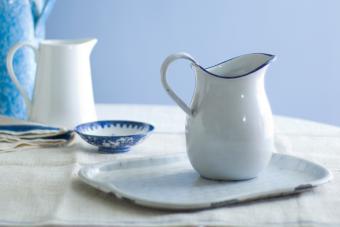Drawer Pulls Are Miniature Works of Art

If you collect antique furniture or want to add a vintage look to your modern cabinets or dressers, it helps to get to know the different types of antique drawer pulls. These old drawer pulls are little works of art, constructed from all different materials and in a wide range of styles. They offer fascinating clues about the history of antique furniture.
Antique Bail Pulls

Bail pulls are one of the most common types of antique drawer pulls you may encounter. A bail pull features a bail, or handle, that is attached by two posts. The handle swings back and forth, allowing you to slip your fingers under it to open the drawer. Often, bail pulls feature a backplate, which is a piece of metal behind the bail that protects the wood from wear and adds decoration.
Pulls With Inlaid Backplates

In some cases, the backplate of a bail pull can be constructed of material that is inlaid, or set into, the wood of the drawer. Often, the material of the backplate is brass or another metal because of its durability, but inlaid backplates can also be bone, china, and other materials. Because it's very labor-intensive to construct, you'll sometimes see this type of backplate on the hardware of very fine, handmade furniture.
Primitive Old Drawer Pulls

The bail pull was first invented in the early 1700s, and some of the most primitive examples can help you date your furniture to early periods. The first bail pulls curved inwards, and they were often attached to the drawer with pins and no backplate. A pull of this style does not always indicate a very old piece of furniture, but it's a clue a dresser or other item could be quite old.
Vintage Ring Pulls

Another style of antique drawer pull is called a "ring" pull. In this type, a ring hangs from a hinge. You slip your fingers through the ring to open the drawer. This is a common style of drawer pull on vintage furniture from the 1900s; however, ring pulls have existed for much longer.
Ring Pulls by Popular Manufacturers

Some manufacturers are particularly desirable, especially when it comes to vintage drawer pulls. The Keeler Brass Co. made drawer pulls in lots of styles, including ring pulls. The pulls aren't usually marked, but you can identify them by looking at other examples made by the company. You'll see Keeler pulls on furniture, especially pieces made in Grand Rapids, Michigan, where the Keeler Brass Co. was based.
Antique Drop Pulls

Like ring pulls, drop pulls hang from a single hinge. Instead of a ring, they have a piece of metal, wood, glass, or another material you can grasp to pull the drawer open. You'll usually see these on dressers, nightstands, and other furniture items. This style of drawer pull was particularly popular during the late 1800s.
Carved Wood Drawer Pulls

Some antique drawer pulls are carved out of wood, often by hand. You'll see these on handmade furniture, especially. Sometimes, the entire pull is intricately carved out of wood. In other cases, the backplate is carved wood and the handle itself is a simple knob. Leaves and flourishes are common design elements, and these carved handles were especially popular during the 1800s.
Simple Knob Handles

Some old dresser pulls are simply metal or wood knobs attached to the drawer. This is common in sewing cabinets or spool cabinets, but you'll also see basic knobs on antique dressers, side tables, and other pieces. It is difficult to use knobs to date a piece of furniture, since this simple design has been popular for centuries.
Sign up for our newsletter featuring all the latest stories and products we love.
Antique Bin Pulls

Bin pulls are another popular style of drawer hardware. Also called "cup pulls," these are solid pulls you can slip your finger under to open the drawer. They were used on bins in dry goods stores, which is likely the source of their name. However, you'll also see these on antique file cabinets, dressers, card catalogs, and Hoosier cabinets. Most date to the 19th and 20th centuries.
Replacing Drawer Hardware

If you are restoring a piece of antique furniture and need to replace the hardware, it's best if you choose a style that is authentic to the piece. You should also select drawer pulls that have the same spacing as the original ones, eliminating the need to drill new holes in your furniture.
To replace drawer hardware, simply use a screwdriver to carefully remove the existing pull from the drawer. Usually, it is attached with screws on the inside of the drawer. After you have removed the existing hardware, you can add the new (or new-to-you) drawer pulls.
Antique Drawer Pulls Offer Clues

In addition to being beautiful, drawer hardware can give you some clues about your old furniture pieces. From the types of screws used to the materials and manufacturing style, you can date antique furniture hardware, and by extension, the furniture associated with it. This can offer valuable information about your most treasured pieces.







